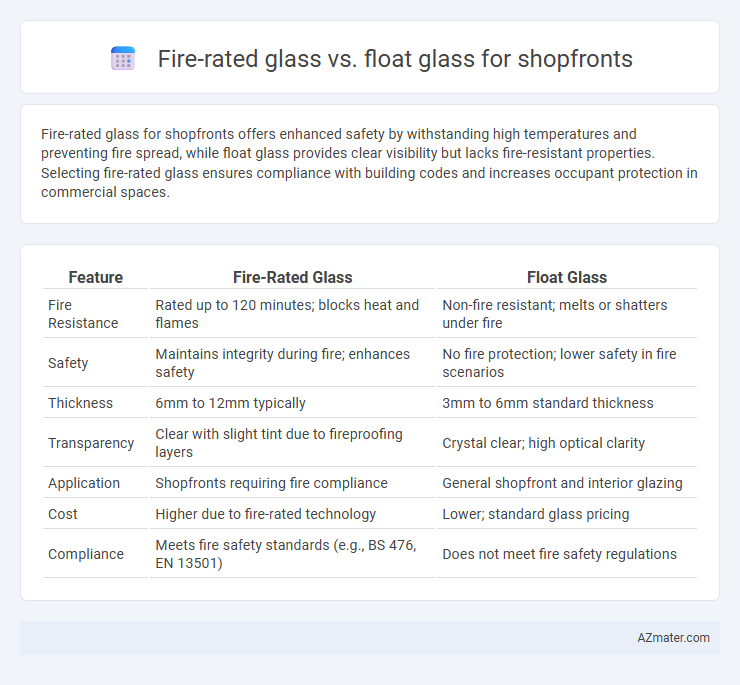Fire-rated glass for shopfronts offers enhanced safety by withstanding high temperatures and preventing fire spread, while float glass provides clear visibility but lacks fire-resistant properties. Selecting fire-rated glass ensures compliance with building codes and increases occupant protection in commercial spaces.
Table of Comparison
| Feature | Fire-Rated Glass | Float Glass |
|---|---|---|
| Fire Resistance | Rated up to 120 minutes; blocks heat and flames | Non-fire resistant; melts or shatters under fire |
| Safety | Maintains integrity during fire; enhances safety | No fire protection; lower safety in fire scenarios |
| Thickness | 6mm to 12mm typically | 3mm to 6mm standard thickness |
| Transparency | Clear with slight tint due to fireproofing layers | Crystal clear; high optical clarity |
| Application | Shopfronts requiring fire compliance | General shopfront and interior glazing |
| Cost | Higher due to fire-rated technology | Lower; standard glass pricing |
| Compliance | Meets fire safety standards (e.g., BS 476, EN 13501) | Does not meet fire safety regulations |
Introduction to Fire-Rated Glass and Float Glass
Fire-rated glass is specially engineered to provide a barrier against fire, with the ability to withstand high temperatures and prevent the spread of flames and smoke, making it essential for shopfronts in compliance with fire safety regulations. Float glass, on the other hand, is a standard, non-fire-resistant glass produced by floating molten glass on a bed of molten metal, primarily used for aesthetics and visibility in shopfronts without fire protection requirements. The key difference lies in fire-rated glass's multi-layered composition and intumescent interlayers designed for thermal resistance, whereas float glass offers clarity and strength but lacks fire-retardant properties.
Key Differences Between Fire-Rated and Float Glass
Fire-rated glass is specifically engineered to withstand high temperatures and prevent the spread of flames and smoke, making it essential for safety in shopfronts requiring fire resistance. Float glass, a basic, untreated glass type, lacks fire protection properties and primarily offers clarity and aesthetic appeal without fire delay capabilities. Key differences include fire resistance duration, with fire-rated glass often rated from 30 to 120 minutes, and construction materials, where fire-rated glass incorporates special interlayers or coatings absent in float glass.
Safety and Security Features
Fire-rated glass offers enhanced safety by resisting high temperatures and preventing the spread of flames and smoke, making it essential for shopfronts in fire-prone areas. Float glass, while cost-effective and clear, lacks fire resistance and does not provide the same level of security against heat or impact. Choosing fire-rated glass ensures compliance with safety regulations and protects occupants and property, whereas float glass primarily serves aesthetic purposes without specialized protection.
Fire Resistance Capabilities
Fire-rated glass offers superior fire resistance capabilities compared to float glass, with the ability to withstand high temperatures and prevent the passage of flames and smoke for up to 120 minutes, depending on the rating. Float glass lacks fireproofing properties, making it vulnerable to rapid breakage and ineffective as a fire barrier in shopfront applications. Incorporating fire-rated glass in shopfronts enhances safety, complies with building codes, and helps contain fire damage within commercial spaces.
Visual Clarity and Aesthetic Appeal
Fire-rated glass offers high visual clarity with specialized coatings that maintain transparency while providing critical fire resistance for shopfronts. Float glass delivers superior aesthetic appeal through a smooth, flawless surface that enhances natural light and reflections but lacks fire protection capabilities. Choosing between fire-rated glass and float glass involves balancing the need for safety compliance with desired storefront elegance.
Durability and Maintenance Requirements
Fire-rated glass offers superior durability compared to float glass, designed to withstand high temperatures and prevent fire spread, making it ideal for shopfront safety. Maintenance of fire-rated glass requires regular inspections for integrity and possible damage to maintain its protective properties, while float glass involves simpler upkeep focused on cleaning and minor repairs. Choosing fire-rated glass enhances long-term safety and durability, despite slightly higher maintenance demands than float glass.
Energy Efficiency and Insulation Properties
Fire-rated glass for shopfronts offers enhanced thermal insulation and energy efficiency by preventing heat transfer and containing fire spread, unlike float glass which provides minimal protection against heat and flame penetration. Fire-rated glass typically incorporates multiple layers and special interlayers that improve thermal resistance and reduce energy loss, maintaining interior temperature more effectively. In contrast, float glass, while cost-effective and clear, lacks the insulating properties needed to optimize energy efficiency in commercial storefront applications.
Cost Comparison: Fire-Rated Glass vs Float Glass
Fire-rated glass typically costs between 50% to 200% more than float glass due to its specialized manufacturing processes and enhanced safety features. The higher price reflects its ability to withstand high temperatures and prevent fire spread, making it a critical investment for compliance with building codes in commercial shopfronts. Float glass offers a more budget-friendly solution for aesthetics but lacks fire resistance, often resulting in increased long-term risk and potential insurance costs.
Regulatory Compliance for Shopfront Installations
Fire-rated glass meets stringent fire safety codes such as NFPA 80 and UL 10C, ensuring compliance with building regulations for shopfront installations in commercial properties. Float glass, while widely used for aesthetic and clarity purposes, lacks the necessary fire resistance and fails to meet fire safety standards required in many jurisdictions. Choosing fire-rated glass not only enhances occupant safety but also ensures adherence to local fire and building codes critical for obtaining installation permits and avoiding legal liabilities.
Choosing the Right Glass for Your Shopfront
Fire-rated glass offers enhanced safety by providing heat resistance and preventing the spread of flames, making it essential for compliance with fire safety regulations in commercial shopfronts. Float glass, while providing clarity and aesthetic appeal, lacks the fire-resistant properties necessary for high-risk areas. Choosing the right glass for your shopfront involves evaluating safety requirements, building codes, and the specific environmental risks of the location to ensure protection without compromising design.

Infographic: Fire-rated glass vs Float glass for Shopfront
 azmater.com
azmater.com